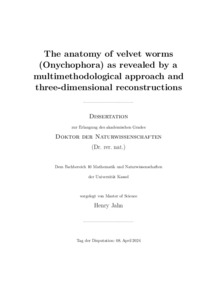| dc.date.accessioned | 2024-04-30T10:14:39Z | |
| dc.date.issued | 2024 | |
| dc.identifier | doi:10.17170/kobra-2024041710029 | |
| dc.identifier.uri | http://hdl.handle.net/123456789/15723 | |
| dc.language.iso | eng | |
| dc.relation.haspart | doi:10.1111/jmi.12688 | |
| dc.relation.haspart | doi:10.1073/pnas.1710742114 | |
| dc.relation.haspart | doi:10.1016/j.cub.2016.07.023 | |
| dc.relation.haspart | doi:10.1007/s00359-017-1186-4 | |
| dc.relation.haspart | doi:10.1186/s12915-021-01196-w | |
| dc.relation.haspart | doi:10.1098/rsos.191200 | |
| dc.relation.haspart | doi:10.1038/s42003-023-04797-z | |
| dc.rights | Urheberrechtlich geschützt | |
| dc.rights.uri | https://rightsstatements.org/page/InC/1.0/ | |
| dc.subject | Onychophora | eng |
| dc.subject | Morphology | eng |
| dc.subject | Circulatory System | eng |
| dc.subject | Nervous System | eng |
| dc.subject | Leg Musculature | eng |
| dc.subject | Anatomy | eng |
| dc.subject | Panarthropoda | eng |
| dc.subject | Three-dimensional Imaging | eng |
| dc.subject | Microscopy | eng |
| dc.subject | Micro-computed Tomography | eng |
| dc.subject.ddc | 590 | |
| dc.title | The anatomy of velvet worms (Onychophora) as revealed by a multimethodological approach and three-dimensional reconstructions | eng |
| dc.type | Dissertation | |
| dcterms.abstract | Onychophorans, or velvet worms, comprise a small group of worm-like, multi-legged terrestrial invertebrates. Since their discovery in 1826, these organisms have been investigated from different perspectives, particularly in the field of morphology—a discipline that provides the basis for functional and evolutionary inferences. Onychophorans are currently classified within Ecdysozoa (moulting animals) and form together with Tardigrada (water bears) and Arthropoda a clade named Panarthropoda. Therefore, onychophorans are an important group to understand key evolutionary processes, such as the transition from a soft-bodied worm-like animal (onychophorans, tardigrades and extinct lobopodians) to organisms equipped with an articulated chitinous exoskeleton (arthropods). In my thesis, I have used a multi-methodological approach to investigate several morphological aspects of the model species Euperipatoides rowelli and infer evolutionary changes in body plans within Panarthropoda. For instance, I applied a combination of non-invasive and high-resolution imaging methods to study details of the circulatory system, the central nervous system, the musculature of walking appendages, the nephridia, the different gland types, and many other organ systems. As a very first step, I evaluated quantitatively and qualitatively the hitherto unknown effects of different contrast agents to onychophoran tissues and organs, and defined the most appropriate approach for X-ray micro-computed tomography (=μCT) imaging. Thereafter, I used synchrotron radiation-based μCT (SR-μCT), three-dimensional reconstructions, histology, scanning electron microscopy, immunohistochemistry, confocal laser scanning microscopy and live imaging for generating detailed morphological information from least studied organ systems. My work unveiled novel anatomical, functional and evolutionary aspects of onychophorans, including (i) the hemolymph pathways within the vascular and lacunar system, (ii) homology of structures associated with the circulatory system of onychophorans and arthropods, (iii) the myoanatomy of the onychophoran leg (=lobopod), and (iv) the first three-dimensional interactive model of the onychophoran organ systems. Finally, μCT analyses of †Cretoperipatus burmiticus, a 100 million-years-old fossil onychophoran preserved in amber, resolved this species within the major subgroup Peripatidae and revealed the migration patterns of these organisms into Southeast Asia. These and other results presented in my thesis arguably contribute for a better understanding of Onychophora and shed light on the evolution of panarthropods. | eng |
| dcterms.accessRights | restricted access | |
| dcterms.creator | Jahn, Henry | |
| dcterms.dateAccepted | 2024-04-08 | |
| dcterms.extent | ix, 519 Seiten | |
| dc.contributor.corporatename | Kassel, Universität Kassel, Fachbereich Mathematik und Naturwissenschaften, Institut für Biologie, Fachgebiet Zoologie | |
| dc.contributor.referee | Mayer, Georg (Prof. Dr.) | |
| dc.contributor.referee | Heethoff, Michael (Prof. Dr.) | |
| dc.contributor.referee | Maniak, Markus (Prof. Dr.) | |
| dc.contributor.referee | Hammel, Jörg. U. (Dr.) | |
| dc.subject.swd | Stummelfüßer | ger |
| dc.subject.swd | Morphologie <Biologie> | ger |
| dc.subject.swd | Kardiovaskuläres System | ger |
| dc.subject.swd | Nervensystem | ger |
| dc.subject.swd | Beinmuskulatur | ger |
| dc.subject.swd | Anatomie | ger |
| dc.subject.swd | Bildgebendes Verfahren | ger |
| dc.subject.swd | Mikroskopie | ger |
| dc.subject.swd | Mikrocomputertomographie | ger |
| dc.type.version | publishedVersion | |
| ubks.embargo.terms | 2026-04-08 | ger |
| ubks.embargo.end | 2026-04-08 | |
| kup.iskup | false | |
| ubks.epflicht | true | |
| ubks.kumDiss | true | |

